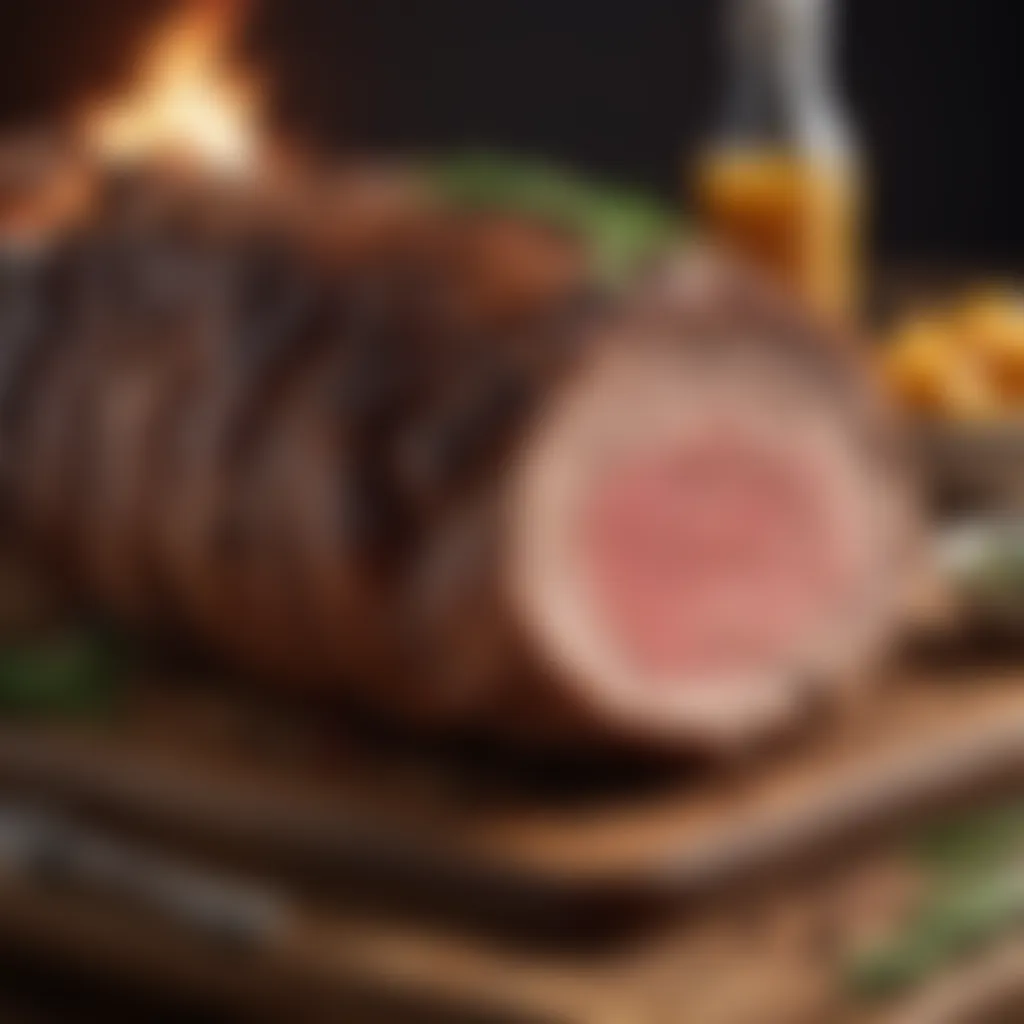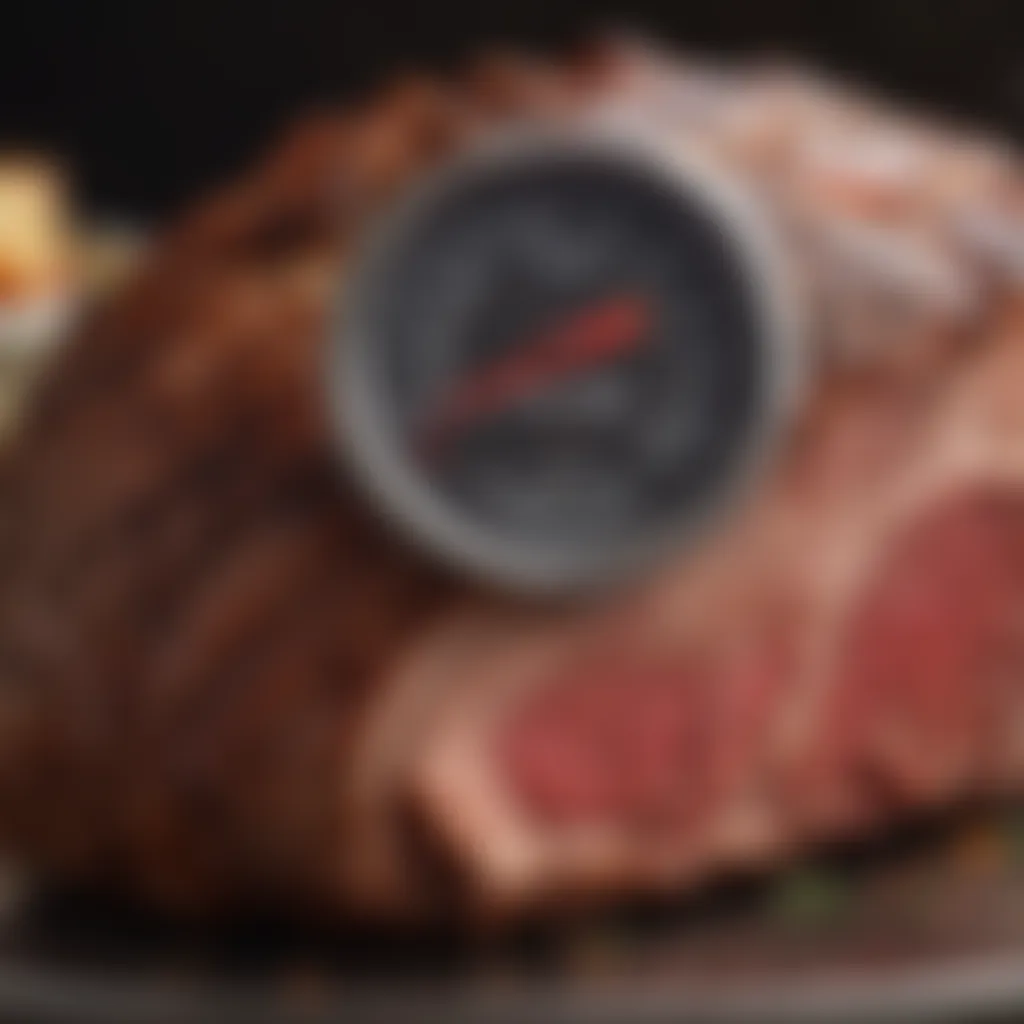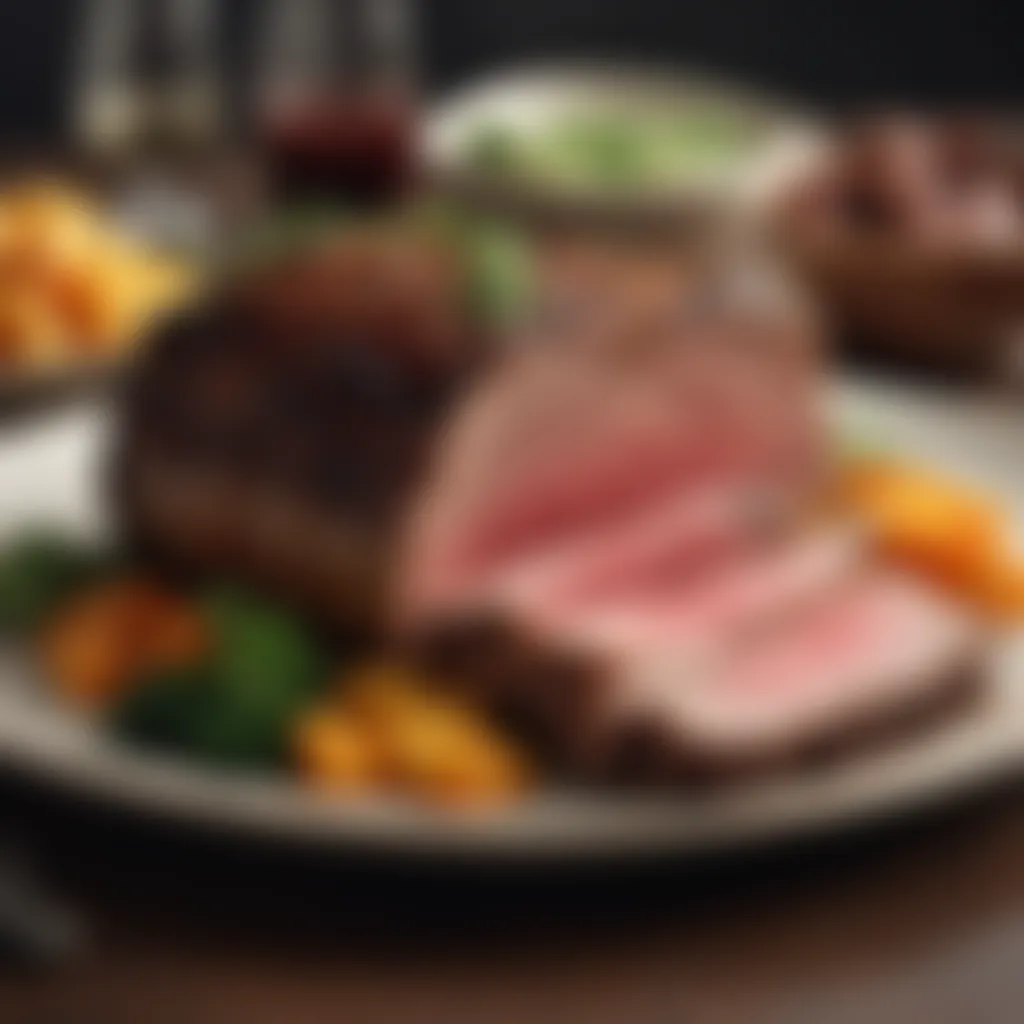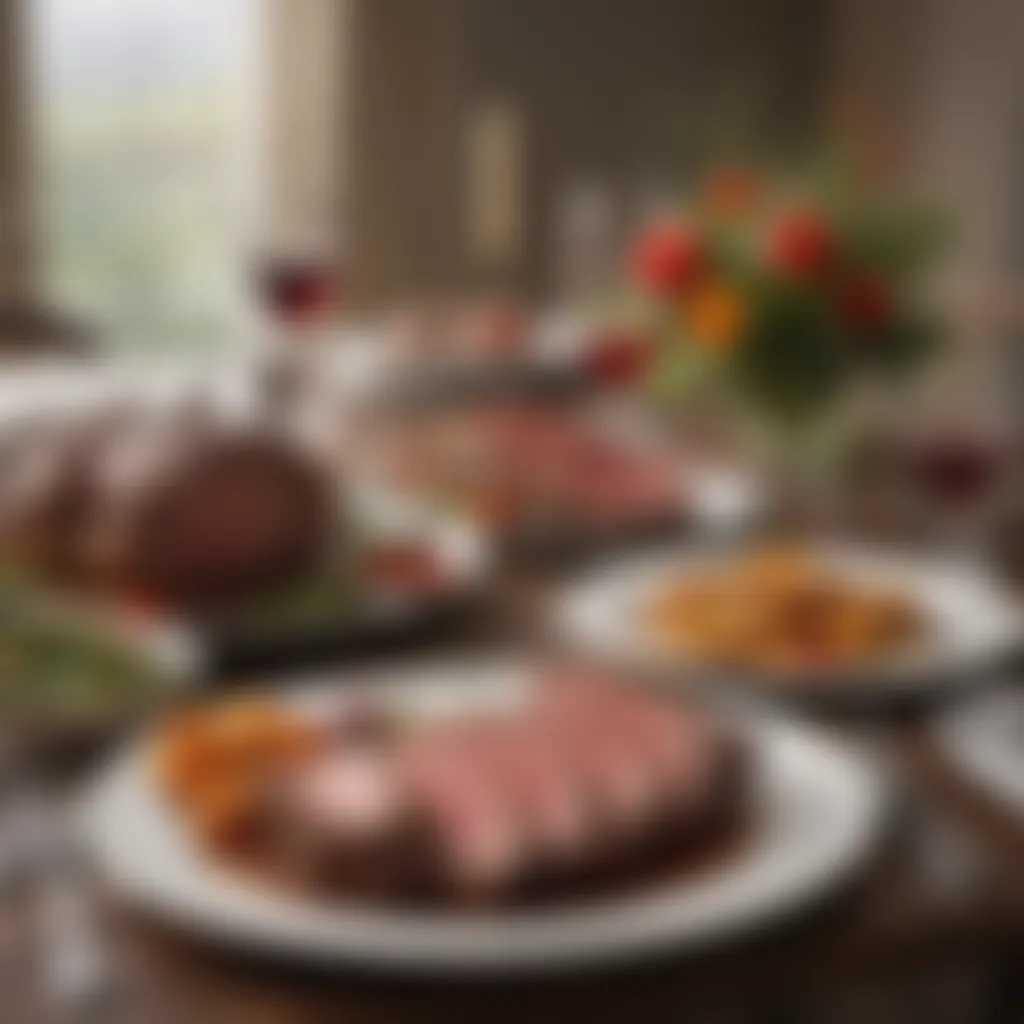Mastering the Art of Cooking Rib Roast


Ingredients:
Cooking a rib roast requires precise ingredients to ensure it is flavorful and cooked to perfection. Here is a detailed list of what you will need:
- Rib roast (bone-in preferred): 4 to 6 pounds
- Kosher salt: 2 to 3 tablespoons
- Black pepper: 1 to 2 tablespoons, freshly cracked
- Garlic: 4 cloves, minced
- Fresh rosemary: 2 tablespoons, finely chopped
- Thyme: 1 tablespoon, finely chopped
- Olive oil: 2 to 3 tablespoons
- Vegetables for roasting (optional): carrots, onions, potatoes, and celery, as preferred
- Beef broth: 1 to 2 cups for basting
Gather these ingredients ahead of time to streamline the cooking process.
Preparation Steps:
Preparation is crucial for a successful rib roast. Here are the step-by-step instructions to follow:
- Selecting the rib roast: Choose a cut that has good marbling. A well-marbled roast results in richer flavor and tenderness.
- Room temperature: Allow the rib roast to sit at room temperature for about an hour before cooking. This helps the meat cook more evenly.
- Seasoning the meat: In a small bowl, combine kosher salt, black pepper, minced garlic, rosemary, and thyme. Rub olive oil over the entire surface of the rib roast. Then, apply the seasoning mixture generously.
- Vegetable preparation: If using vegetables, chop them into uniform sizes for even cooking. Place them in the bottom of a roasting pan.
- Preheat the oven: Set your oven temperature to 450°F (232°C) to create the initial sear.
Technical Aspects:
Understanding the technical elements of cooking a rib roast is essential. Here are the key factors to consider:
- Cooking temperature: The initial high temperature (450°F) sears the outside, locking in flavors. Then reduce it to 325°F (163°C) for the remaining cook time.
- Timing specifics: A general guideline is to cook the roast for about 15-18 minutes per pound for medium-rare. Adjust the time according to your preferred doneness.
- Internal temperature: Using a meat thermometer is vital. Aim for 130°F (54°C) for medium-rare or 140°F (60°C) for medium doneness.
Cooking Process:
The actual cooking process involves specific, detailed steps:
- Searing the roast: Place the rib roast in the preheated oven for the first 20 minutes. This develops color and flavor.
- Lower the temperature: After 20 minutes, reduce the oven temperature to 325°F (163°C) and continue cooking.
- Basting: Baste the roast with beef broth every 30 minutes. This adds moisture and enhances flavor.
- Checking doneness: Use a meat thermometer to check the temperature around the end of cooking. Remove the roast from the oven once it reaches the desired internal temperature.
- Resting: Let the rib roast rest for at least 15-20 minutes before carving. This allows juices to redistribute.
Troubleshooting Tips:
Even the best cooks encounter issues. Here are tips to solve common problems:
- If the roast is cooking too fast: Lower the oven temperature immediately to slow it down.
- If too much fat is present: Trim some fat before cooking to ensure even cooking and flavor.
- For uneven doneness: Rotate the roast halfway through cooking for even heat distribution.
To achieve culinary excellence, focus on the preparation and timing. An intentional approach leads to superb results.
By following this detailed guide, you can prepare a rib roast that impressively showcases your culinary skills.
Understanding Rib Roast
Understanding the rib roast is fundamental for anyone looking to master this cooking technique. It serves not just as a dish but as a centerpiece for gatherings and celebrations. Knowing the different types and characteristics can enhance your culinary skills, ensuring that you select the best roast for any occasion. When one understands rib roast, they can cater to the tastes and preferences of their guests, making every meal a memorable experience. This section uncovers the essential elements and considerations that will pave the way for successful rib roast recipes.
Definition of Rib Roast
A rib roast is a cut of beef taken from the rib section of the cow. It consists of several rib bones, which surround the prime cuts of meat. The rib roast is known for its tenderness and flavor, making it a popular choice for special occasions. This roast can be served as a piece or cut into individual steaks, depending on preference. It’s characterized by its rich marbling, which contributes to its juicy texture and robust taste.
Types of Rib Roast
Rib roasts can vary significantly, depending on the specific cut preferred. Understanding these types helps in selecting the right one for your needs.
Prime Rib
The prime rib is often considered the gold standard of rib roasts. The name itself implies high quality, as it comes from well-marbled beef that results in a tender and flavorful experience. One key characteristic of the prime rib is its excellent balance between lean meat and fat, which provides texture and flavor during cooking. This makes it a popular choice among housewives looking to impress family and friends at gatherings.
The unique feature of prime rib is that it can be cooked to various degrees of doneness without sacrificing tenderness. However, it is generally more expensive than other roast options due to its quality. This can be seen as a disadvantage if budget constraints are a factor.
Standing Rib Roast
The standing rib roast is structured differently, as it is usually presented with the rib bones left intact. This cut is visually appealing and often used for festive occasions. The primary advantage of this roast is its impressive presentation, which tends to draw attention during gatherings. It is also known for a superior flavor, thanks to the fat cap on the top that melts and infuses flavor into the meat as it cooks.
A disadvantage may include a longer cooking time due to its size. An inexperienced cook might under or overcook it, which can lead to inconsistent results. It is crucial to monitor this roast closely to achieve the desired doneness.
Rolled Rib Roast


The rolled rib roast is a boneless version where the rib eye muscle is tied to maintain its shape. This cut is perfect for those who prefer a uniform piece of meat that is easy to carve. Its primary characteristic is the absence of bones, making it simpler to cook and more versatile in various recipes.
The unique advantage here is the ease of cooking and serving. However, some may argue that it loses a bit of the traditional flavor that the bone imparts during cooking. This can be a consideration for those who prioritize flavor over convenience.
Culinary Significance
The rib roast is not just a meal; it holds cultural and historical importance in many cuisines. Containing cuts that emphasize quality, the rib roast reflects a deep understanding of meat preparation and cooking methods. It encourages experimentation with flavors and cooking techniques, appealing to both novice cooks and seasoned chefs. By appreciating the culinary significance of rib roast, one can learn to respect the ingredients and the process, leading to a more rewarding cooking experience. Understanding these elements ultimately assists in elevating one's cooking to a higher standard, yielding gratifying results.
Key Factors Influencing Cooking Time
Understanding the key factors that influence cooking time is essential for preparing a rib roast to perfection. Various elements impact how the roast cooks, including its weight, desired doneness, oven temperature, and resting period. Each of these aspects carries certain responsibilities in the overall cooking process. By considering these factors, you will enhance your ability to produce a rib roast that meets the culinary standards you strive for.
Weight of the Rib Roast
The weight of the rib roast is a primary concern. It determines the cooking time and affects how heat penetrates the meat. Generally, larger cuts require more time to cook thoroughly. For instance, a three-bone rib roast may take much longer than a one-bone piece. Furthermore, factors like bone-in versus boneless can alter the duration as well. It is essential to adjust cooking guidelines based on the precise weight to ensure proper doneness.
Desired Doneness
The level of doneness significantly impacts the cooking time and overall flavor profile.
Rare
Rare is often considered the most tender state for a rib roast. The meat remains red in the center and juicy. This choice is popular among those who appreciate the melt-in-your-mouth texture. However, achieving rare requires precise control over temperature and timing. It may not suit everyone’s palate, as some find it too undercooked for their preference.
Medium-Rare
Medium-rare is perhaps the most celebrated choice for rib roasts. It features a warm pink center filled with moisture. This doneness strikes a balance between juiciness and flavor. Many chefs recommend this level because it brings out the natural flavors of the beef without sacrificing tenderness. The disadvantage is that it can be finicky, requiring careful monitoring.
Medium
A medium rib roast presents a firmer texture with a slight pink hue. This level is suitable for those who prefer a stronger beef flavor while still enjoying some juiciness. Although it sacrifices some tenderness, it can cater to a broader audience. However, overcooking is a risk, and it may dry out if not monitored closely.
Medium-Well
Medium-well offers a mostly brown interior with a hint of pink. This doneness provides a more robust texture but can lead to a loss in juiciness. Many people find it preferable because it minimizes the risk of undercooked meat. The challenge lies in strategically timing the cooking process to avoid dryness.
Well-Done
Well-done is for those who seek fully cooked meat without any pink. It is firm and lacks moisture, which can lead to a less enjoyable dining experience. While suitable for certain individuals, it often results in an unattractive texture when dealing with rib roast. The key is to time it properly to prevent excessive dryness.
Oven Temperature
The chosen oven temperature greatly influences the cooking duration and final texture of the rib roast.
Low and Slow Method
The low and slow method entails cooking at a lower temperature for a more extended period. This technique allows the meat to become exceptionally tender and flavorful. It accommodates the natural marbling, enhancing the overall taste. However, it requires patience, as the cooking process can exceed several hours.
High Heat Method
On the other hand, the high heat method involves cooking at a significantly higher temperature for a shorter duration. This approach yields a crisp crust on the exterior while aiming to retain moisture inside. However, timing becomes critical. Failure to monitor the roast can lead to overcooked meat and an unsatisfactory result.
Resting Period
Resting the rib roast post-cooking is a must. Allowing the meat to sit for a sufficient time enables juices to redistribute throughout the cut. This step enhances tenderness and flavor. Typically, resting for about 15 to 30 minutes should suffice, depending on the size of your roast. Skipping this essential phase may lead to disappointment, as carving too early can result in a dry and unappealing dish.
Cooking Techniques for Rib Roast
Cooking a rib roast is not merely about time and temperature; it involves mastering techniques that elevate the dish. The correct methods ensure even cooking, flavor enhancement, and texture optimization. Understanding cooking techniques can turn an ordinary meal into a memorable feast. The layered complexity contributes to achieving the perfect rib roast, influencing the final outcome significantly.
Initial Preparation


Preparing a rib roast starts with selecting quality meat. The cut should exhibit good marbling for flavor and tenderness. Before cooking, let the roast sit at room temperature for about an hour. This helps it cook evenly. Trim excessive fat, but leave a layer for flavor durability during roasting. Dry the meat with paper towels to ensure a good sear later on, vital for flavor development.
Seasoning Options
Proper seasoning can enhance the rib roast's inherent flavors. There are various approaches to seasoning, each offering unique benefits.
Salt and Pepper Method
The salt and pepper method is straightforward yet effective. A generous application of coarse salt enhances moisture retention, while freshly cracked pepper adds depth. This method emphasizes the natural flavors of the beef. It is popular due to its simplicity and effectiveness in allowing the meat's quality to shine through. However, it lacks complexity compared to more elaborate spice blends, which may not suit every palate.
Herb Crust Considerations
Creating an herb crust involves a mixture of fresh herbs like rosemary, thyme, and parsley. This method provides aromatic oils that infuse the meat as it cooks. The key characteristic of this technique is the complementary flavor profile, making it a favored option for many chefs. One drawback is that some may find the herb flavor leads to masking the meat's robust taste. Therefore, balance is essential when selecting herbs.
Garlic and Butter Techniques
Using garlic and butter can make a rib roast extra luxurious. Rubbing garlic cloves into the meat and applying a generous amount of softened butter before roasting enhances the richness. This method is especially beneficial for achieving a golden crust packed with flavor. The unique feature is the combination of richness and aromatic qualities of garlic, which some find irresistible. However, it might be too indulgent for others looking for a more straightforward approach.
Searing the Roast
Searing is crucial for flavor development. This process creates a caramelized exterior that locks in juices. A hot pan or grill is essential for this step. Sear all sides until they brown. This not only enhances flavor but also establishes texture, contributing to the overall culinary experience. Avoid overcrowding the pan, as this can reduce the heat needed for proper browning.
Roasting Process
Once seared, the rib roast transitions to the oven. Preheat your oven based on your cooking method, whether low and slow or a high heat approach. Monitor the roast to ensure even cooking; typically, it requires careful temperature management. Rotate the roast if necessary. Using a roasting pan with a rack prevents the meat from sitting in its own juices.
Using a Meat Thermometer
Utilizing a meat thermometer is a reliable way to ensure your rib roast reaches the desired doneness. Insert the thermometer into the thickest part of the meat, away from bones and fat. Different doneness levels require different internal temperatures. Here is the guideline:
- Rare: 120°F (49°C)
- Medium-Rare: 130°F (54°C)
- Medium: 140°F (60°C)
- Medium-Well: 150°F (66°C)
- Well-Done: 160°F (71°C)
By keeping an eye on temperature, you can avoid overcooking or undercooking. Let the rib roast rest after removing it for even juice distribution, enhancing your final dish.
Calculating Cooking Time
Calculating cooking time for a rib roast is vital in achieving the desired doneness and overall quality of the meat. Knowing the precise duration helps avoid common pitfalls such as overcooking or undercooking. Each rib roast has specific characteristics, including weight and thickness, that directly influence how long it should cook. This section outlines these key elements and offers benefits and considerations to keep in mind while determining the cooking time.
Understanding cooking time contributes to a more pleasant dining experience. A well-cooked rib roast not only ensures optimal flavors but also enhances tenderness, making every bite enjoyable. It's essential to approach this aspect with precision.
"Cooking time is not just a guideline. It's the path to culinary perfection."
General Time Guidelines
General time guidelines serve as a starting point for cooking a rib roast. While these guidelines vary based on factors like the roast type and oven temperature, they can still provide a reliable framework.
- Rare: Cook for about 15 to 20 minutes per pound.
- Medium-Rare: 20 to 25 minutes per pound.
- Medium: Aim for 25 to 30 minutes per pound.
- Medium-Well: Approximately 30 to 35 minutes per pound.
- Well-Done: Expect 35 to 40 minutes per pound.
These times consider a standard oven temperature of 325°F (163°C), which is commonly recommended for roasting. Adjustments may be necessary depending on the actual weight of the roast and other cooking methods employed.
Using a Cooking Chart
Using a cooking chart can streamline the process of calculating time. Such charts typically display roasting times correlated to the weight of the rib roast and the chosen doneness level. These tools are particularly beneficial for home cooks seeking consistency and accuracy.
When using a cooking chart, ensure the following:
- Weight: Always weigh your rib roast before consulting the chart.
- Type of Roast: Indicate the type, as variations in structure may alter cooking times.
- Desired Doneness: Choose the doneness level to cross-reference with the appropriate time.
Cooking charts are available in many cookbooks or online resources, like websites and forums dedicated to culinary arts. They enable cooks, from novices to experienced, to make informed decisions based on reliable data.
Utilizing both general guidelines and specific charts helps eliminate guesswork. This approach enhances confidence and leads to a successfully cooked rib roast.


Post-Cooking Procedures
The conclusion of the cooking process is essential to achieving a delicious rib roast. The post-cooking procedures ensure that the flavors meld together and that the meat maintains its quality. Ignoring these steps can lead to disappointing results. Following the right procedures helps in enhancing the final taste and texture of the roast.
Resting the Rib Roast
Resting is a crucial step after cooking a rib roast. This period allows the juices within the meat to redistribute, leading to a juicier and more flavorful roast. If you cut into the roast immediately after removing it from the oven, the juices will escape, resulting in a dry piece of meat. It is advisable to let the roast rest for at least 20 to 30 minutes before carving.
During this time, loosely tent the roast with aluminum foil. This method keeps the heat in while allowing the exterior to maintain warmth without cooking further. The internal temperature can rise slightly during this phase, which is particularly beneficial for achieving the desired doneness.
Carving Techniques
Carving a rib roast may seem daunting, but it is straightforward with the right approach. First, ensure you have a sharp carving knife and a sturdy cutting board. Let the roast rest, as mentioned before, to make carving easier.
- Remove the Frenched Bones: If your rib roast has Frenched bones, it is common to remove them for easier slicing. Cut along the bones and gently lift them away from the meat.
- Identify the Grain: It is important to identify the direction of the muscle fibers or grain. Cutting against the grain helps in achieving tender slices.
- Slice Thinly: Create even slices that are about 1/2 inch thick, ensuring the pieces are manageable for serving.
Using these techniques will not only present a beautiful dish but also enhance the eating experience.
Serving Suggestions
Once the rib roast is beautifully carved, it’s time to consider how to serve it. There are several approaches you can take.
- Classic Presentation: Arrange the slices on a platter, garnished with fresh herbs, such as rosemary or thyme, for added aroma and appeal.
- Sauces and Gravies: Serve with horseradish sauce or a rich gravy. These sides complement the flavors of the roast well.
- Pairing Sides: Consider traditional side dishes like mashed potatoes, roasted vegetables, or Yorkshire pudding. These pair nicely with the rib roast, creating a well-rounded meal.
Post-cooking procedures are integral. Taking time to rest, carve properly, and serve thoughtfully ensures your rib roast is not only delicious but also inviting. Remember to enjoy the process of serving this delightful dish, as it brings satisfaction not just for the palate but also for the soul.
Common Mistakes to Avoid
When embarking on the culinary journey of cooking a rib roast, potential pitfalls are ever-present. Understanding common mistakes not only improves your cooking skills but also safeguards your investment in quality meat. Rib roasts, whether they are Prime Rib, Standing Rib Roast, or Rolled Rib Roast, require careful preparation and attention. By recognizing these errors, you enhance flavor, tenderness, and presentation of the final dish, contributing significantly to the overall culinary experience.
Overcooking
Overcooking is a frequent misstep in preparing a rib roast. It can lead to a tough and dry end product, stripping away the juiciness that characterizes a well-cooked roast. This mistake often results from not monitoring the internal temperature closely. The ideal range for a medium-rare rib roast is about 130-135°F (54-57°C). Cooking beyond this range can diminish quality significantly.
One way to prevent overcooking is to trust a reliable meat thermometer. Insert it into the thickest part of the roast before removing it from the oven. It's crucial to pull it out shortly before you expect it to reach the desired temperature. The roast continues to cook during the resting period, a phenomenon known as carryover cooking. Be prepared to account for this quarter to half a degree increase.
Here are some tips to avoid overcooking:
- Use a meat thermometer: This is essential for precise monitoring.
- Know your oven: Each oven has its quirks. Some run hotter or cooler than indicated.
- Follow guides: Refer to established cooking time charts for rib roasts based on weight.
Underestimating Resting Time
A critical yet often overlooked step is the resting period after cooking. Many home cooks underestimate its importance, believing they can serve immediately after removing the roast from the oven. However, during the resting phase, juices redistribute throughout the meat. If you skip this step, cutting into your roast too soon can lead to a significant loss of moisture, resulting in a less flavorful dish.
The recommended resting time typically ranges from 20 to 30 minutes for a rib roast, depending on its size. During this time, it is advisable to loosely cover the roast with aluminum foil. This technique keeps the heat in while allowing air to circulate, preventing excess condensation.
Consider the following to optimize your resting period:
- Plan your timing: Ensure you incorporate the resting period into your cooking schedule.
- Keep it covered: Use foil to retain heat without steaming the meat.
- Resist the urge: Wait before slicing into your roast, trusting the process will enhance flavor.
"Understanding and avoiding these common mistakes can significantly elevate your cooking experience and outcome."
By being aware of these common errors and implementing corrective measures, your efforts in making a rib roast will yield spectacular results. Quality cooking hinges on mindfulness and technique, and avoiding overcooking and allowing for proper resting time are foundational elements in this culinary endeavor.
Culmination
In this article, the conclusion serves as a vital point of reflection on the entire process of cooking a rib roast. It emphasizes how understanding the intricacies discussed can elevate the cooking experience from merely following a recipe to mastering a culinary technique.
The essence of a successful rib roast lies in careful consideration of several key factors such as cooking time, desired doneness, and the proper resting period. These elements ensure that the roast is not only cooked to perfection but also delivers optimal flavor and tenderness.
Moreover, mastering the art of rib roast preparation offers numerous benefits:
- Culinary Confidence: Gaining knowledge about cooking techniques enhances overall kitchen proficiency. This confidence can lead to the exploration of other meats and dishes.
- Quality Results: Attention to detail results in a roast that is consistently flavorful and appealing, transforming your dining experience.
- Family Gatherings: A well-cooked rib roast becomes the centerpiece of family meals or special occasions, fostering memories and shared experiences.
Throughout this guide, the importance of practice and patience is noted. Each cooking attempt, regardless of the outcome, provides learning opportunities that add to one’s culinary journey.
"Cooking is an art that requires patience, practice, and understanding of the ingredients."
This carefully curated knowledge will equip you to approach rib roast cooking with assurance, transforming your culinary ideas into reality with impressive results.







